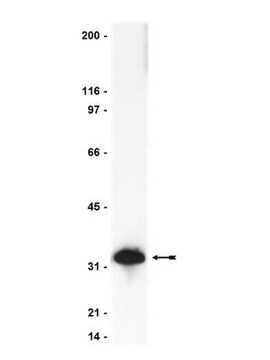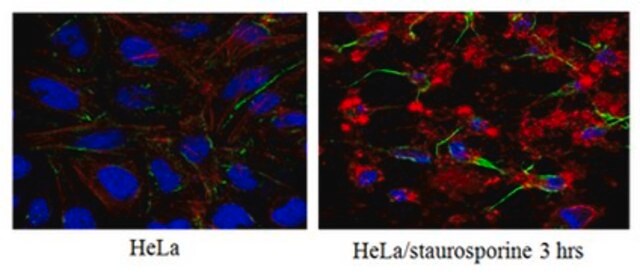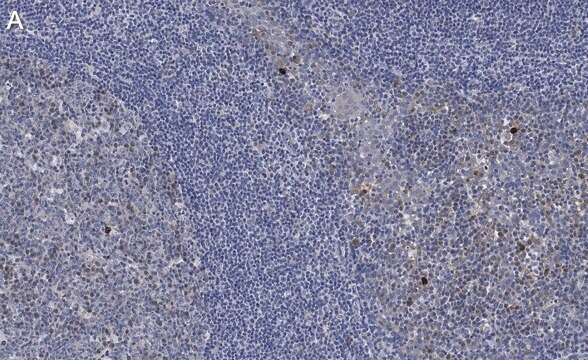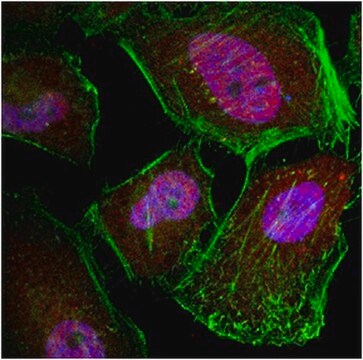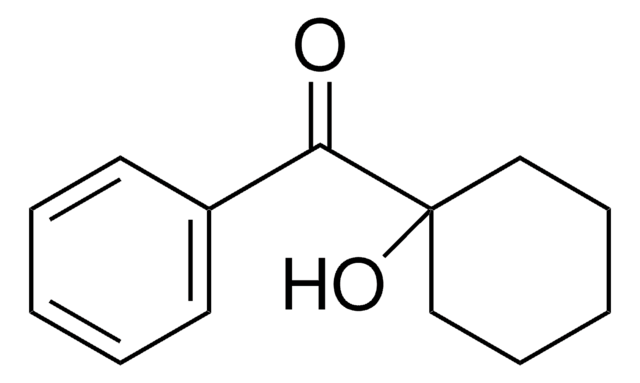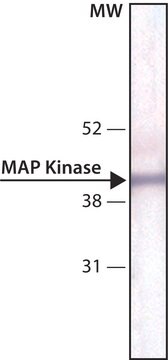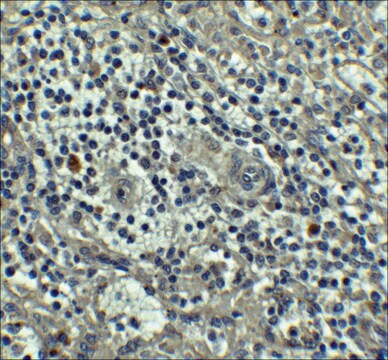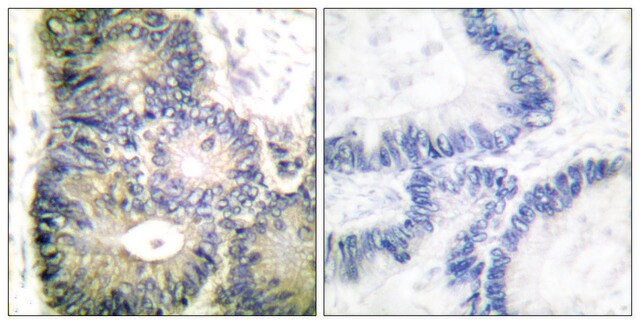C5737
Monoclonal Anti-Caspase 3 antibody produced in mouse
clone 84803.111, purified immunoglobulin, lyophilized powder
Synonim(y):
Anti-Apopain, Anti-CPP32, Anti-Yama
Zaloguj sięWyświetlanie cen organizacyjnych i kontraktowych
About This Item
Polecane produkty
pochodzenie biologiczne
mouse
Poziom jakości
białko sprzężone
unconjugated
forma przeciwciała
purified immunoglobulin
rodzaj przeciwciała
primary antibodies
klon
84803.111, monoclonal
Formularz
lyophilized powder
reaktywność gatunkowa
human
metody
western blot: 1.0 μg/mL using human Jurkat cells
izotyp
IgG2b
numer dostępu UniProt
temp. przechowywania
−20°C
docelowa modyfikacja potranslacyjna
unmodified
informacje o genach
human ... CASP3(836)
Powiązane kategorie
Opis ogólny
CASP3 (kaspaza 3) jest proteazą cysteinową należącą do rodziny białek kaspazowych i jest spokrewniona z enzymem konwertującym interleukinę-1β (ICE). Jest ludzkim homologiem białka Ced-3 Caenorhabditis elegans. Białko to stanowi kluczowy element apoptozy.
Specyficzność
Detects recombinant human precursor caspase 3 and the 18 kDa form produced during apoptosis.
Immunogen
recombinant 18 kDa subunit, amino acids 29-175, of human caspase 3.
Działania biochem./fizjol.
CASP3 (kaspaza 3) jest niezbędnym białkiem apoptozy, które obejmuje wiele sygnałów indukujących śmierć, a kaspaza 3 działa na ostatnich etapach zaprogramowanej śmierci komórki. Wykazano, że białko to ulega ekspresji w raku płaskonabłonkowym przełyku (ESCC), a jego obniżona regulacja jest związana ze zwiększoną złośliwością i zmniejszonym całkowitym przeżyciem. Jego ekspresja w przerzutowych węzłach chłonnych (LN) może służyć jako marker złego rokowania przeżycia u pacjentów z resekowanym ESCC i przerzutami do LN. Badania nad wieloma nowotworami, takimi jak rak żołądka, jelita grubego, jajnika i szyjki macicy pokazują, że nieprawidłowa ekspresja tego genu jest związana z progresją raka i agresywnym zachowaniem. Może on mieć potencjał jako marker określający rokowanie w powyższych nowotworach.
Postać fizyczna
Lyophilized from a 0.2 μm filtered solution in 0.01 M phosphate buffered saline with 5% trehalose.
Oświadczenie o zrzeczeniu się odpowiedzialności
O ile nie określono inaczej w naszym katalogu lub innej dokumentacji firmy dołączonej do produktu(-ów), nasze produkty są przeznaczone wyłącznie do użytku badawczego i nie mogą być wykorzystywane do żadnych innych celów, w tym między innymi do nieautoryzowanych zastosowań komercyjnych, zastosowań diagnostycznych in vitro, zastosowań terapeutycznych ex vivo lub in vivo lub jakiegokolwiek rodzaju konsumpcji lub zastosowania u ludzi lub zwierząt.
Ta strona może zawierać tekst przetłumaczony maszynowo.
Nie możesz znaleźć właściwego produktu?
Wypróbuj nasz Narzędzie selektora produktów.
polecane
Kod klasy składowania
11 - Combustible Solids
Klasa zagrożenia wodnego (WGK)
WGK 1
Temperatura zapłonu (°F)
Not applicable
Temperatura zapłonu (°C)
Not applicable
Wybierz jedną z najnowszych wersji:
Masz już ten produkt?
Dokumenty związane z niedawno zakupionymi produktami zostały zamieszczone w Bibliotece dokumentów.
Klienci oglądali również te produkty
Qian Hu et al.
International journal of clinical and experimental pathology, 7(8), 5057-5070 (2014-09-10)
Emerging evidence has indicated that apoptotic cells have a compensatory effect on the proliferation of neighboring cells. Recent studies have shown that apoptotic tumor cells stimulate the repopulation of tumors from a small number of surviving cells by cleaved caspase-3
Xiu-Shen Wang et al.
World journal of gastroenterology, 20(15), 4414-4420 (2014-04-26)
To assess whether differential expression of caspase-3 in paired metastatic lymph nodes (LNs) is prognostic of survival in patients with resectable esophageal squamous cell carcinoma (ESCC). Capases-3 expression was evaluated immunohistochemically in 122 pairs of primary ESCCs and regional metastatic
Tingting Gu et al.
Oncology letters, 14(6), 6815-6822 (2018-02-10)
The present study explored the expression of tetraspanin 1 (TSPAN1) in esophageal carcinoma (EC) and its association with clinicopathological factors. TSPAN1 small interfering RNA (siRNA) was designed to target the TSPAN1 gene in Eca-109 cells in order to explore the
Chuandong Zhu et al.
Oncology letters, 15(4), 4221-4228 (2018-03-20)
The high atomic number of gold nanoparticles (GNPs) enables them to offer potential as practical and efficient radiosensitizing agents for cancer radiotherapy applications. In the present study, it was demonstrated that GNPs can significantly modulate the irradiation response of hepatocellular
Javier Marqués et al.
Antioxidants (Basel, Switzerland), 11(11) (2022-11-12)
NADPH oxidases (NOX) constitute the main reactive oxygen species (ROS) source in blood vessels. An oxidative stress situation due to ROS overproduction can lead into endothelial dysfunction, a molecular mechanism that precedes cardiovascular diseases (CVDs) such as atherosclerosis, myocardial infarction
Nasz zespół naukowców ma doświadczenie we wszystkich obszarach badań, w tym w naukach przyrodniczych, materiałoznawstwie, syntezie chemicznej, chromatografii, analityce i wielu innych dziedzinach.
Skontaktuj się z zespołem ds. pomocy technicznej
